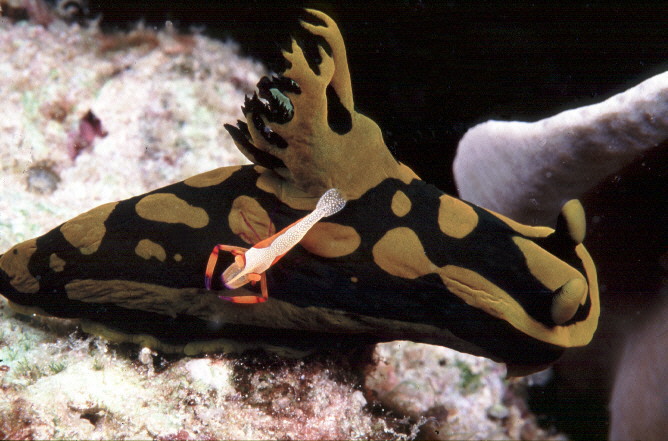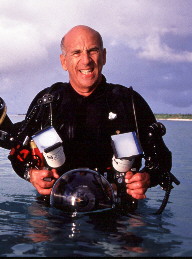
| Tambja sp. Courtesy of Steve Drogin Kungkungan Bay Resort Oct., 1997 |
Tambja sp.
Well we don't have a name for this weeks "Branch of the Week", but we do have a pretty interesting story. It involves the rather unlikely hitch hiker in Steve's photo. It, we have a name for. This beautiful, ten legged beast is the commensal shrimp, Periclimenes imperator Bruce, 1967. Is this newly discovered Tambja it's preferred host?, No. Members of the commensal shrimp group referred to as Pontoniinae shrimp almost exclusively live on a single host species (see Gosliner, Behrens & Williams 1996, pages 202-208 for a couple dozen species in this group). Unlike other pontonine shrimp, P. imperator does live with more than one species. Debelius 1996 (pages 122, #1&4; 123, #6&8) show this shrimp with several species of nudibranch and a gastropod host. It is most common and predictably found, however, on the the large and gorgious Spanish Dancer, Hexabranchus sanquineus and on several echinoderms, notably the sea cucumbers, Stichopus, Bodadschia and Synapta and the sea star, Gomophia. Depending upon the host species, the shrimp is seen in one of two color phases: the one seen in Steve's photo, the pincers and legs purple and the body outline orange(the color exclusively seen when living with echinoderms), and the pink with tiny white speckled phase shown in this link to Mike Miller's photograph on Hexabranchus.
Whether living on a nudibranch or on a sea cucumber, the host benefits from the shrimps "preening" behaviour, the shrimp cleaning the body surface of the host, and in the case of nudibranchs, feeding on the fecal pellets, which are discharged from the anus which is located in the center of the nudibranchs gill (a curious place to locate one's excremental organ).
Often times found in pairs on their host, this species of shrimp is found throughout the Indo-Pacific and may reach an inch in length.
OKay, how about the branch? Well this is only the second specimen I have seen, the first was photographed by Jeff Rosenfeld, colleague from the State of Washington, while diving in the same location as Steve. Not too much to say, except that this species is apparently quite large and grazes out in the open on reef faces. The color pattern of the two speciemens is absolutely identical with a broad orange margin around the head and along the foot margin. It has a large rounded rhomboidal orange patch in the head, a oval patch mid-dorsally and numerous large patches on the sides of the body and tail regions. The gills and rhinophores are a similar orange color. This species of Tambja was thought to be a species recently described by Nathalie Yonow as Tambja olivaria Yonow, 1994 from the Maldives. I am sure hers is distinct from this present critter, as seen by major differences in Nathalie's drawing and color plate.
Keep your eyes open for this new guy on the block!
Photo courtesy of Steve Drogin of San Diego, Calif:

Steve is a 58 year old amateur Diver/Photographer who spends full time traveling and diving the globe. He lives in La Jolla, California and is a member of the San Diego Underwater Photographic Society. His photographic credits include a recent article on the sunken fleet of Bikini Atoll in Sports Divers Journal(Issue 16) . Send Steve mail at sbdrogin@mill.net |
Taxonomic information courtesy of:

David W. Behrens
Author:
Pacific Coast Nudibranchs
Send Dave mail at seachalleng@earthlink.net
|
© The Slug Site, Michael D. Miller 1997 All Rights Reserved.
